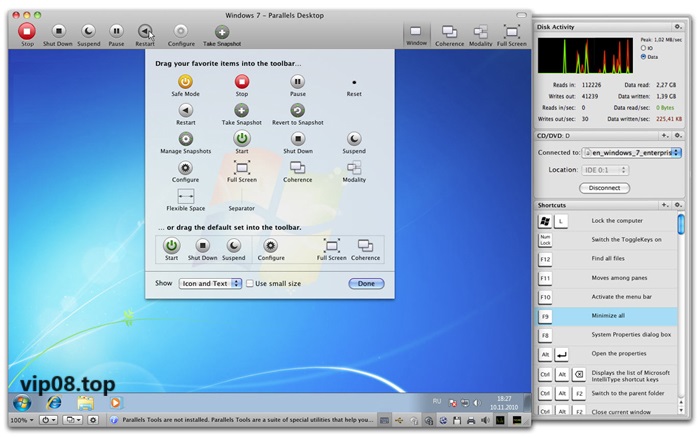In the world of virtualization and operating systems options for Mac users Two giants are prominent: Parallels Vs. Bootcamp Performance. Both of them offer distinct ways to run Windows in your Mac Each having its own unique strengths and drawbacks. The decision of Parallels and Bootcamp will have a significant impact on overall experience of your computer and in this thorough review we will dive deep into the intricacies of each options to assist you in making an informed choice.
Understanding Parallels

The Parallels Advantage
- Parallels Desktop is an application for virtualization that lets users to use Windows along with macOS in your Mac. The software creates the virtual machine (VM) which allows you to download and use Windows applications with ease. Parallels Desktop method is all about conveniences and integrations.
- With Parallels it is possible to switch to macOS as well as Windows applications with ease, just like if they were running directly on the Mac. This integration level guarantees an enjoyable person revel in. It’s miles especially useful whilst you need to make seamless switching among both operating structures.
Performance in Parallels
- In terms of speed, Parallels Performance has come a considerable amount in the last few years. It gives remarkable hardware accelerations that allows windows to perform at a close to native velocity in digital environment. This means that you can play resource intensive games with no performance loss.
- Parallels also comes with a feature known as Coherence Mode that allows Windows apps appear like they are operating directly from your Mac desktop.
Bootcamp: A Different Approach

Bootcamp’s Strengths
- Bootcamp is, on the other hand, uses an entirely different approach for running Windows in your Mac. In lieu of virtualization Bootcamp lets you create an additional partition on the hard drive of your Mac and then install Windows as like it was the primary operating system. This is basically operating Windows in its native form.
- One of the best benefit of Bootcamp is its performance. Because you run Windows direct on the hardware you will get the best performance from Windows games and applications. Bootcamp is the best option for those who need the highest performance when performing tasks that requires a lot of resources.
Performance in Bootcamp
Bootcamp excels in term of performance. When you start Windows with Bootcamp, you basically turn your Mac into an Windows PC. Which means you are capable of use the most abilities of the hardware to your Mac which includes the GPU, CPU, and RAM, to run home windows applications. Video editors, gamers, and professionals who depend on Windows-specific software typically choose Bootcamp because of its performance advantages.
A Head-to-Head Comparison
User-Friendliness
In the war of Parallels against. Bootcamp, user-friendliness is an important factor. Parallels is the clear winner in this regard, due to the seamless interface and user-friendly. It is possible to change to macOS and Windows by a single click and is accessible to users of all skill levels. Bootcamp however, on the other side, requires a reboot to switch between the two operating systems. This is not ideal to multitask.
Performance
In terms of raw speed, Bootcamp emerges as the top choice. Because Bootcamp runs Windows natively, it is able to completely utilize the hardware of your Mac and deliver top-quality performance. Parallels provides great performance however it isn’t able to match the performance of native Bootcamp for games and applications that require a lot of effort. games.
Integration
Parallels excels in integration. It lets you run windows application on macOS, ensuing an unbeatable experience. Bootcamp is a separate partition, does not offer the same degree of integration. It requires a reboot in order to change to macOS and Windows and this can cause disruption to your workflow.
Compatibility
Compatibility is another factor to take into consideration. Parallels is compatible with a variety guests operating system, and not only Windows. Bootcamp however, on the other side, is developed specifically for Windows and macOS which limits its compatibility to other OS.

- Compatibility and Software Support
A crucial aspect to take into consideration is compatibility and the support for software offered by Parallels as well as Bootcamp. Parallels, as an alternative to virtualization is renowned for its wide compatibility with different operating systems. Beyond Windows it is possible to use Linux versions, Android as well as older editions that run macOS in Parallels. Bootcamp On the other on the other hand, was made to run Windows in conjunction with Mac hardware. Although it is a great choice for offering native performance for Windows software, it might not be the ideal option if you require access to a variety of operating systems and applications. If you have particular requirements for software that aren’t met by Windows, Parallels offers more flexibility. - Security and Isolation
Security is essential in today’s digital environment and it is the same for both Parallels and Bootcamp have different approaches to it. Parallels creates a virtual world that is able to isolate Windows from macOS offering a extra layer of protection. It’s true that since it’s a software-based system vulnerability in the virtualization program could be exploited. Bootcamp which is a separate partition, offers a higher degree of security. Windows runs independently of macOS, reducing the risk of cross-contamination between both operating systems. - Storage Space Considerations
The decision of Parallels vs. Bootcamp performance will also affect the storage space you have. Parallels generates virtual disks which can expand in size when you install more programs and data in your virtual computer. This means that you must allot a certain amount of your Mac’s storage to the virtual machine. And when you’re running empty, you might require resizing your virtual disk. Bootcamp On the other side, has a separate partition that is assigned at the time of initial installation. While this gives the benefits of native performance however, it also means that some of the hard disk will be always committed to Windows. If you have limited storage capacity on your Mac, this consideration becomes crucial as it could impact your decision. - Ease of Backup and Recovery
Parallels has backup and snapshot capabilities within the virtual environment which makes it easy creating backups for your Windows system. If you experience a problem you can go back to an earlier snapshot to repair your system. Bootcamp However, it is dependent on backup methods that are traditional for your Windows files, since it operates natively. This means that you have to manage backups in a separate manner for macOS and Windows which is more difficult and time-consuming. In the end, the choice in between Parallels and Bootcamp should be based upon your particular needs, priorities and the kind of work that you do with your Mac.
Resource Usage
![]()
Parallels Desktop an application for virtualisation, uses system resources such as RAM and CPU in order to operate the virtual machines. Bootcamp is a Windows-based application, and since it operates Windows natively, does not use resources shared with macOS. If resource use is an issue to you, Bootcamp might be the best choice.
Price
Cost is an aspect that should not be overlooked. Parallels Desktop requires a monthly subscription that can increase over time. Bootcamp however, on the other side, is completely free and is included in your Mac. If price is a major factor, Bootcamp has the edge.
Support and Updates
The two programs Parallels vs. Bootcamp performance get frequent updates as well as support. Parallels provides excellent customer support and a regular update schedule for compatibility to the most recent macOS as well as Windows versions. Bootcamp, being an official Apple product, receives regular updates; however, it may have limited compatibility with non-Apple hardware.
Conclusion
In the fight of Parallels vs. Bootcamp performance, there isn’t a clear winner, since the decision is largely based on your individual requirements and preferences. If you’re looking for seamless integration, user-friendly and the capability for running Windows applications with macOS applications, then Parallels is the best way to take. It is a first rate option for the ones who have to replace among each working systems regularly. However If performance is your primary concern, Bootcamp is the better alternative.Think about what is most important to you – ease of use and integration, or raw power and performance, and then make your decision based on that. Whatever you decide to go with the two Parallels and Bootcamp provide reliable solutions to run Windows for your Mac and ensuring you will get the best combination of the two.